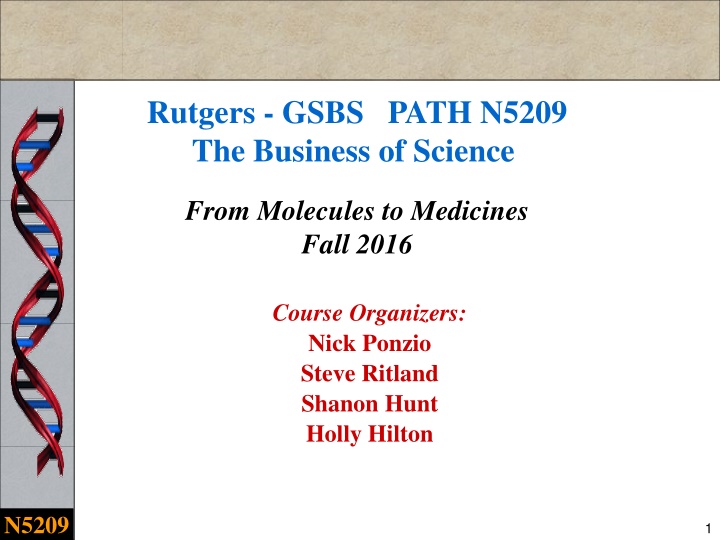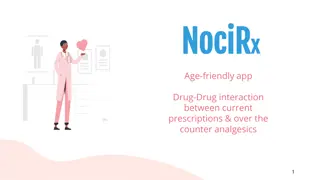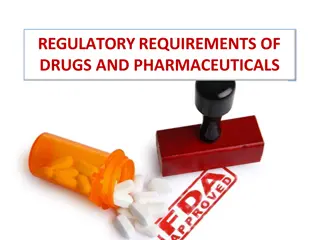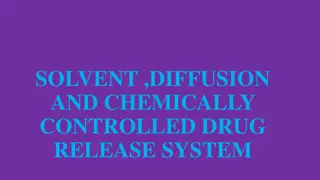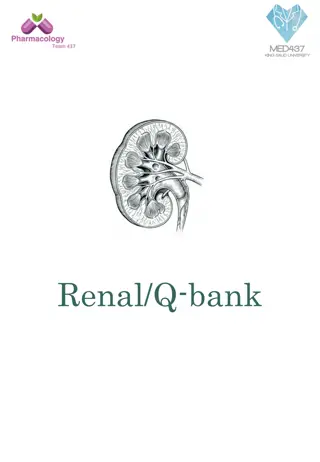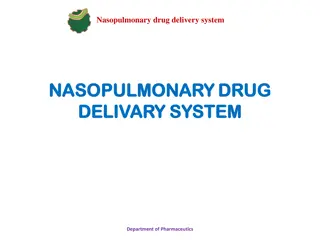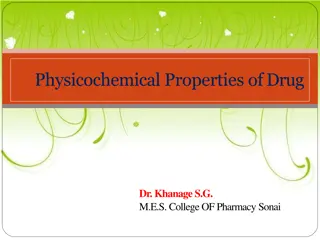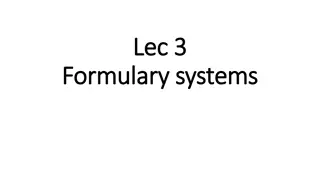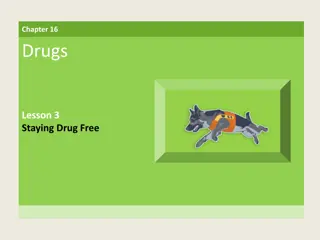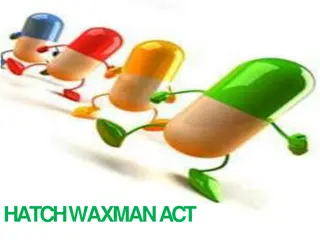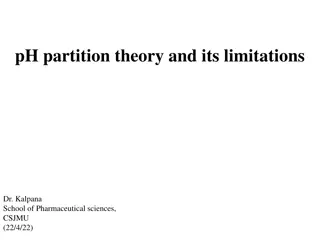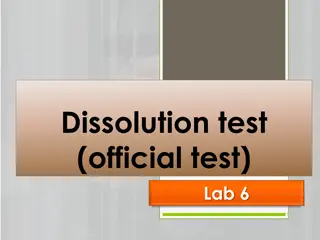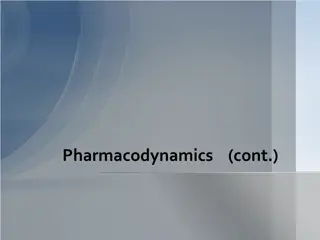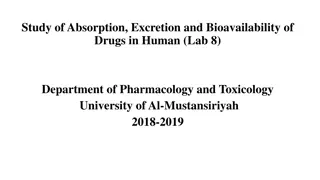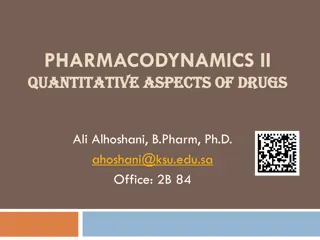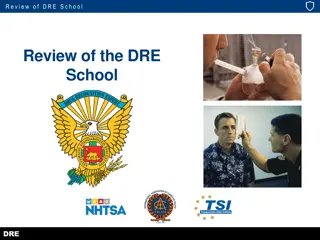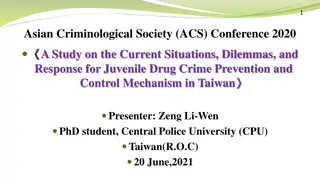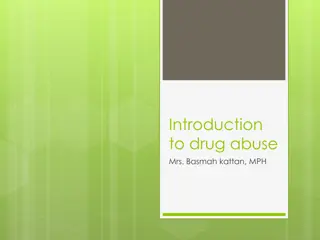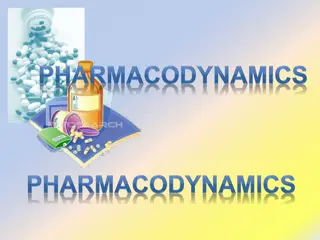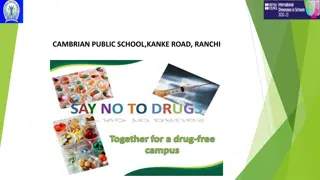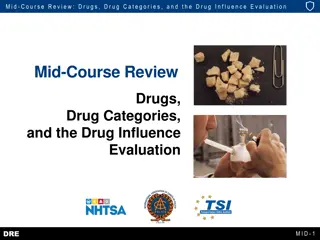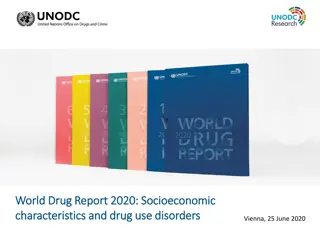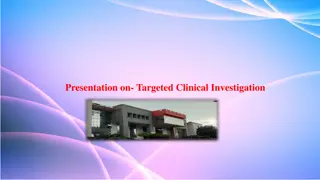The Business of Science: Drug Development Insights
This course delves into the creation of new drugs, offering a practical understanding of the biotech/pharma industry. Through real-world examples and projects, you'll explore the processes, collaborations, and career opportunities in drug development. Active participation, critical thinking, and professional presentation skills are emphasized for a hands-on learning experience.
Download Presentation

Please find below an Image/Link to download the presentation.
The content on the website is provided AS IS for your information and personal use only. It may not be sold, licensed, or shared on other websites without obtaining consent from the author.If you encounter any issues during the download, it is possible that the publisher has removed the file from their server.
You are allowed to download the files provided on this website for personal or commercial use, subject to the condition that they are used lawfully. All files are the property of their respective owners.
The content on the website is provided AS IS for your information and personal use only. It may not be sold, licensed, or shared on other websites without obtaining consent from the author.
E N D
Presentation Transcript
Rutgers - GSBS PATH N5209 The Business of Science From Molecules to Medicines Fall 2016 Course Organizers: Nick Ponzio Steve Ritland Shanon Hunt Holly Hilton N5209 1
Todays Agenda Welcome and Introduction (Nick) A whirlwind tour of drug discovery and development (Shanon) Business meets Science: The Drug Innovation Industry (Steve) Course structure and deliverables (Shanon) Project team: Introduction to your target Course Website: http://njms.rutgers.edu/gsbs/olc/fmtm/ N5209 2
Introduction This course is about how new drugs get created This course will provide An introduction to the Big Picture of How Things Are Actually Done in Biotech/Pharma Insight into the day-to-day activities of scientists / clinicians working in industry Practical experience in how molecules move through the drug development cycle ( semester project) Examples of areas where industry and academia collaborate to solve healthcare problems Examples of career possibilities related to stages of the drug development cycle for graduates with advanced degrees in biomedical sciences Whether you pursue a career in industry or academics, it s an advantage to understand how the biotech/pharma industry works N5209 3
Course Directors N5209 4
Will work for Diet Coke! N5209 5
Expectations and Evaluation Expectations: Courtesy to our guest speakers and team members Active participation in group work and Project Teams Critical Thinking applying concepts from lectures to the team project that you will develop Evaluation: No Exams ! (are you kidding me?) Several oral team presentations Project Portfolio Class assignments and participation (by course directors) Peer feedback on team participation N5209 6
If you think what you are doing in school is only to please your teacher or get a grade, you are missing a chance to not only learn, but also practice what you will be doing in the real world after you graduate. So: Be on time Be prepared Speak up and contribute without fear Collaborate on your projects Make professional presentations N5209 7
M2M Biotechnology M2M Biotechnology specializes in the full drug discovery and development lifecycle through first US Registration. MM As M2MBio employees, you will work on one of 3 teams involved in developing new drugs N5209 8
Field Trips! N5209 9
Faculty and Student Introductions Nick 1. Your name 2. Your major (or your job) 3. 4. Your prior experience (if any) with Pharma/Biotech Your favorite way to celebrate after your (successful) project presentations! N5209 10
Course Structure and Organization Shanon N5209 11
Course Overview When and where you need to be Session Dates Wednesday evenings Sept 7 - Dec 21 (see syllabus) Session Times 6:00 PM - 9:00 PM (with one break, if you re really, really lucky) Classroom Location GSBS Newark Campus Medical Sciences Building (MSB) in the Department of Pathology Room C-555 (main lecture); breakout rooms for team activities Critical Due Dates Date of your assigned Debate Session MC Presentation #1: October 19 MC Presentation #2: November 16 Final Project Portfolios: December 21th (last day of class) N5209 12
Course Overview How you ll spend your class time Lecture (first ~1hour of each class) Each session will begin with a high level Introduction of the topic and its context for your semester project Activities Section (~2 hours for each class) Activities will apply concepts from that day s lecture The activities conducted in class will be part of your Project Portfolio, due at the end of the course. 6 pm ~ 7:00 15 mins 7:15 ~ 9 pm Lecture Break Activities N5209 13
Game Rules Lectures Our guest speakers are industry professionals who volunteer their time to teach this class. 1. Please come to class on time. 2. Please do not do emails, texts, Amazon shopping, etc. during lectures. Computers or notepads are fine for taking notes, and they will be very useful during project time (the second half of class), so please bring them. 3. Please feel free to ask questions/interact with lecturers. This is a good opportunity for you to get to know experts in their fields who do drug development every day. N5209 14
What you will deliver over the semester The good... Textbook: There is no expensive text book needed. We will provide articles as pre-read. Exams: There are no exams in this course! Semester Project: The Project Portfolio Project portfolio: You will build you final project portfolio one step at a time as we proceed through the individual class sessions Debates: are more fun than work, honest. The bad... Two Class Presentations Teams: Your team members, therapeutic area, and target/compound are assigned (welcome to our world) Team grading: You will be graded as a team on your project portfolio including a component of peer feedback One Topic Debate The ugly... Presentations: Holly has been known to bring students to tears...but Steve will make it up to you with a beer afterward. N5209 15
Semester Project Project Portfolios Course Overview The Project Portfolio (PP) is a collection of deliverables that you will prepare over the course of the semester Each group will be required to submit a project portfolio at the end of the semester PPs will count for 30% of your semester grade Due Date: December 21 Project Portfolios include the following: 1. Executive Summary 2. Overview of Disease Pathogenesis, Epidemiology, and Current Treatment 3. Target Rationale 4. Investigator s Brochure (Non-clinical Section) 5. Phase 1 Protocol Synopsis Summary 6. Investigator s Brochure (Clinical Section) 7. Target Product Profile (Start of Phase 3) 8. Gantt Chart 9. Lifecycle Strategic Plan N5209 16
Course Overview Group Presentations Management Committee Requests for Decision Each group will develop and deliver two Management Committee Presentations (20 min. each) This is a decision point presentation, with a request to management Teams must select 2-3 presenters for each of the presentations (all team members must present at least once) Week 7: MC Presentation #1 Entry into Development Portfolio Therapeutic Area Target, MoA, Scientific Rationale Pharmacology 20% of your final grade Week 11: MC Presentation #2 Proof of Concept, Entry into Phase 3 Opportunity assessment, market potential CMC strategy to FMI Clinical Proof of Concept (Ph1 & 2 data, efficacy & safety) 20% of your final grade N5209 17
Course Overview Class Debates; Assignments and Participation Debates: 4 6 people will be assigned to each debate, assignments to follow Students will need to prepare for their role ahead of class More details on the debates will be provided as we get closer Debates will count for 10% of your final grade Week 8 (Oct 26) Ethics of Ph1 studies: How much risk? Week 12 (Nov 30) Expedited Approvals: Success or Failure? Week 14 (Dec 14) Drug Pricing and Access: What is fair? Class Assignments and Participation: These count for 10% of your final grade N5209 18
Course Overview Peer Evaluation - Teams Feedback from your teammates will determine 10% of your final grade Team Peer Feedback Form Evaluator: ___________ Team member being evaluated: _______________________ 1.This team member contributed substantially to developing the project strategy Yes ___ Comments: No ___ 2.This team member contributed substantially to management committee presentations Yes ___ Comments: No ___ 3.This team member contributed substantially to the final project portfolio Yes ___ Comments: No ___ Overall peer review rating: ____ (score 5% for each Yes answer to a maximum of 15%) N5209 19
Session Evaluation Your feedback helps lecturers and course design Course Overview After EACH lecture... Shared with organizers and lectureres Student Feedback Form Session Date: ___________ Session Topic: _______________________ My satisfaction level with the overall course thus far is: (circle one) 1 2 3 4 5 Low Medium My satisfaction with this particular sessionis: (circle one) 1 2 3 4 5 Low Medium Specific comments and suggestions (What worked well? Do you have any constructive feedback?): 6 7 8 9 10 High 6 7 8 9 10 High N5209 20
Course Website Resources for Students Course Overview http://njms.rutgers.edu/gsbs/olc/fmtm/ Course Syllabus Schedule of Classes and Topics Course logistics Project information Background Reading Course Files Organized by session date Reference articles/pre-read material Lecture presentations Examples and templates for exercises Relevant websites Faculty contact info N5209 21
M2M Biotechnology M2M Biotechnology specializes in the full drug discovery and development lifecycle through first US Registration. MM M2M s expertise covers oncology, inflammation and autoimmune diseases. The current M2M pipeline includes: CDK4/6 in solid tumors FGFR in solid tumors PDE4 in chronic inflammation JNK in fibrosis 22
Project Team and Debate Assignments N5209 23
Assignment for Tonight Team Introductions Collect your group into a breakout room Introduce yourselves and your background Research and discuss your target for the semester project Start with the articles we provided Understand the target, the pathway, and potential therapeutic applications What other companies are developing agents with this target, and what diseases are they in? N5209 24
Q&A N5209 25
A Whirlwind Overview of DD (Shanon) N5209 26
Overview of Drug Discovery and Development The fairy-tale version 2-6 years Target identification, lead identification, lead optimization, clinical candidate selection Discovery Starts after a lead molecule (clinical candidate) is found Lab testing, animal studies for safety (tox studies) and efficacy Phase 0 IND 20-80 Healthy Volunteers Purpose: determine safety and dosage Phase 1 Health Authority End of Ph 1 Meeting 100-300 Patients Purpose: demonstrate efficacy Phase 2 Health Authority End of Ph 2 Meeting Phase 3 1000-5000 Patients Purpose: monitor adverse reactions to long term use NDA Launch! 16 0 2 4 6 8 10 12 14 18 Years N5209 27
Q: Is it really this simple? A: No way. It is not a stepwise linear process. The compound could be sent backward to further explore a safety issue or even skip phases Some phases might be duplicated (e.g, combinations) There is considerable overlap of activities between Phases. Toxicology animal studies continue to the NDA Phase 1 or Phase 2 clinical trials can be running concurrently with Phase 3 trials Phase 1/2 studies...Phase 2/3 studies.... There are other aspects of drug development beyond the Clinical Plan Health Authorities beyond the FDA, like MHRA (UK), Health Canada, Ministry of Health (China), PMDA (Japan) Parallel development processes: drug manufacturing (CMC), companion diagnostics New competitor activities or changes in market demand could change the development strategy (Business teams) N5209 28
LEE011 Clinical Development Overview 2014 2015 2015 2016 2012 2013 2013 2014 Q1 Q2 Q3 Q4 Q1 Q2 Q3 Q4 Q1 Q2 Q3 Q4 Q1 Q2 Q3 Q4 LEE011X2101 FIH single agent LEE011X2102 Ph1 s.a. Pediatric MRT/NB FPFV May LEE011X1101 Japan s.a. solid tumors FPFV June LEE011 s/a in teratoma FPFV June FPFV June PHASE 1/2 MELANOMA STUDIES MEK162X2114 Ph1b/2 combo LEE + MEK162 N-RAS melanoma LEE011X2105 Ph1b/2 combo LEE + LGX818 BRAF melanoma FPFV Sept LGX818X2102 Phase 2 rational combo study BRAF melanoma FPFV Sept MEK162X2110 Phase 2 triple combo LGX+MEK+LEE BRAF melanoma PHASE 1/2 BC STUDIES LEE011X2106 Ph1b/2 combo LEE + RAD011 and exemestane in BC LEE011X2107 Ph1b/2 combo LEE + Let BYL in ER+ BC LEE011X2108 Ph1b/2 combo LEE + Fulv + BYL/BKM in ER+ BC MONALEESA-1 Ph2 pre-surgical PD dose opt Ph2 Neoadjuvant ER+ HER2- Premenopausal Women MONALEESA-3 Phase 1/2, HER2+ mBC, Trastuzumab-Resistant Patients MONALEESA-5 Phase 3: ER+ HER2- untreated mBC PHASE 3 STUDIES MONALEESA-2 Ph3: ER+ HER2- mBC after NSAI MONALEESA-4 Phase 3 HR+ HER2+ Untreated mBC MONALEESA-6 NSCLC LEE011 + LDK378 in pts with NSCLC 29 N5209 | LEE011 | LEE F2F 2013 | S Hunt | LEE at 40K | Confidential
TRD Development Plan 4Q2013 1Q2014 2Q2014 3Q2014 4Q2014 1Q2015 2Q2015 3Q2015 4Q2015 1Q2016 2Q2016 3Q2016 4Q2016 SDP DDP/FDP CD&MA ML-2, ER+ HER2- untreated mBC ML-4, ER+ HER2- mBC after NSAI BE study DiC vs FCTDecision Point: if BE +, decide between tablet and DiC if BE -, continue both development streams CPIC DS (March) PC1-500kg LC1-750kg PAC3-300kg Resupply 2 - 750kg CHAD LC2-500kg PAC4-350kg Resupply 1 - 750kg DS reg stabs program CPIC DP (March) DiC New qualification equipment order, delivery, installation, QbD3.1 verificati on 1 QbD3.2 verificati on 2 PHAD / PharmOps PDC WS2 PDC WS3 DiC resupply PDC WS4 DiC DP reg stab program QbD2 -FMI pilot FCT-RC PDC WS2 Targeting 50-200-300 mg tablet strengths. Details tbd at PDC WS2 QbD3.2 verificati on 2 QbD3.1 verificati on 1 Transfer to PharmOps/ WST Scale-up (405) QbD2 -FMI lab/pilot PDC WS3 PED oral liquid PDC WS4 QbD3.2 verificati on 2 QbD3.1 verificati on 1 PDC WS2 Transfer to PharmOps Scale-up (Siegfried) QbD1&2 -FMI lab/pilot PDC WS3 PDC WS4 N5209 | LEE011 EPT Feb 14, 2014 | TRD Update | Business Use Only 30
Overview of Drug Discovery and Development The fairy-tale version 2-6 years Target identification, lead identification, lead optimization, clinical candidate selection Discovery Starts after a lead molecule (clinical candidate) is found Lab testing, animal studies for safety (tox studies) and efficacy Phase 0 IND 20-80 Healthy Volunteers Purpose: determine safety and dosage Phase 1 Health Authority End of Ph 1 Meeting 100-300 Patients Purpose: demonstrate efficacy Phase 2 Health Authority End of Ph 2 Meeting Phase 3 1000-5000 Patients Purpose: monitor adverse reactions to long term use NDA Launch! 16 0 2 4 6 8 10 12 14 18 Years N5209 31
All said and done, Drug Development can rival the US Immigration Process N5209 32
Drug Development ...is typically organized into three groups Discovery Research Pre-clinical Dev t Early Development PoC Dev t Exploratory Dev t Phase 1 Dev t Full Development Late Stage Dev t Global Dev t Confirmatory Dev t N5209 33
Overview of Drug Discovery and Development Discovery Lead Series Identified (LSI) Clinical Lead(s) Selected (CLS) Clinical Candidate(s) Selected (CCS) Target Assessment (TA) Entry Into Human (EIH) Target Identification and Validation Lead Lead Preclinical or Nonclinical Testing Identification Optimization Identify a biological pathway and molecular structure of interest Identify one or more leads (biological or chemical compounds) that interact with the target to get the desired therapeutic effect. Demonstrate safety in animals prior to human trials, show therapeutic advantages Optimize the physicochemical characteristics of the compound to make it more druggable. Genomics Proteomics Literature/research GLP Tox High Throughput IND In silico modeling Package N5209 34
Overview of Drug Discovery and Development Exploratory Development Start of Phase 3 Entry Into Human (EIH) or FIH FIM Start of Phase 2 Phase 2 PoC Phase 1 Evaluate safety in healthy human volunteers Evaluate efficacy and side effects in patients Establish PK and PD profile for better characterized drugs. Establish PK and PD profile for better characterized drugs. Dosage Biomarkers Modeling and Treatment N5209 35
Overview of Drug Discovery and Development Confirmatory Development Filing Decision Post Marketing Phase 3 NDA Approval and Launch Evaluate use of the drug in different patient groups Demonstrate/confirm the compound is as effective as existing drugs, if not more so Identify new therapeutic opportunities Refine safety profile (long-term toxicity, undesirable side effects) across a large number of patients Develop new formulations Post Approval Market Preparation Brand N5209 36
